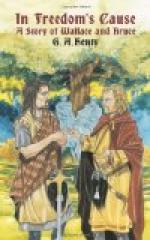This army surpassed both in numbers and equipments any that Edward I had ever led into Scotland, and is considered to have been the most numerous and best equipped that ever before or since has gathered on English ground. Of the whole of the great nobles of England only four were absent — the Earls of Warrenne, Lancaster, Arundel, and Warwick — who, however, sent their feudal arrays under the charge of relations.
Among the leaders of this great army were the Earls of Gloucester, Pembroke, Hereford, and Angus, Lord Clifford, Sir John Comyn, Sir Henry Beaumont, Sir John Seagrave, Sir Edmund Morley, Sir Ingram de Umfraville, Sir Marmaduke de Twenge, and Sir Giles de Argentine, one of the most famous of the Continental knights.
While this vast army had been preparing, Bruce had made every effort to meet the storm, and all who were loyal and who were able to carry weapons were summoned to meet at Torwood, near Stirling, previous to the 24th of June. Here Edward Bruce, Sir James Douglas, Randolph, Earl of Moray, Walter the Steward, Angus of Isla, Sir Archibald Forbes, and a few other knights and barons assembled with 30,000 fighting men, besides camp followers and servants. It was a small force indeed to meet the great army which was advancing against it, and in cavalry in particular it was extremely weak. The English army crossed the Border, and marched by Linlithgow and Falkirk toward the Torwood.
Each army had stirring memories to inspire it, for the English in their march crossed over the field of Falkirk, where sixteen years before they had crushed the stubborn squares of Wallace; while from the spot which Bruce selected as his battleground could be seen the Abbey Craig, overlooking the scene of the Scottish victory of Stirling Bridge. On the approach of the English the Scotch fell back from the Torwood to some high ground near Stirling now called the New Park. The lower ground, now rich agricultural land called the Carse, was then wholly swamp. Had it not been so, the position now taken up by Bruce would have laid the road to Stirling open to the English.
The Scotch army was divided into four divisions. The centre was commanded by Randolph. Edward Bruce commanded the second, which formed the right wing. Walter the Steward commanded the left wing, under the guidance of Douglas, while the king himself took command of the fourth division, which formed the reserve, and was stationed in rear of the centre in readiness to move to the assistance of either of the other divisions which might be hard pressed. The camp followers, with the baggage and provisions, were stationed behind the Gillies Hill.




